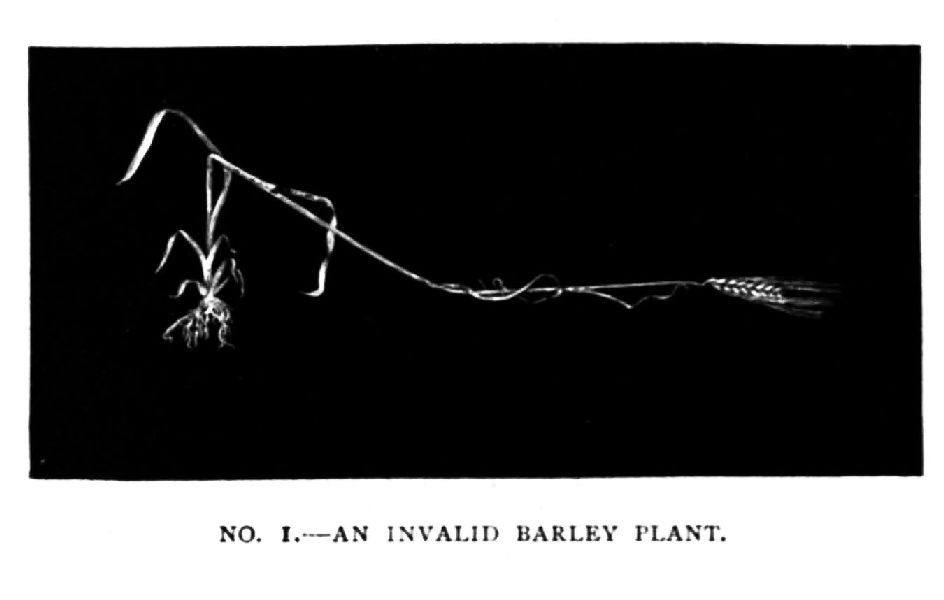
OUR worst enemies are not always the most apparent ones. It is easy enough to build forts for the protection of our towns and harbours against French or Germans, but it is very difficult to devise means of defence against such insidious foreign invaders as the influenza germ or the Colorado beetle. France lost much by the war with Germany, but she probably lost more by the silent onslaught of the tiny phylloxera, which attacked her vineyards — attacked them, literally, root and branch, and paralysed for several years one of her richest industries. Yet invasions like these, being less obvious to the eye than the landing of a boat-load of French or German marines on some bare rock in the Pacific claimed by Britain, attract far less attention than aggressions on the Niger or advances in Central Africa. The smallness of the foe makes us overlook its real strength — it has the force of numbers. We forget that while we can exterminate hostile human bands with Armstrongs and torpedo-boats, the resources of civilisation are still all but powerless against the potato blight, the vine disease, and the destroying microbe.
The enemies of our corn crops in particular are many and various. There is the wheat-beetle, for example, which ravages the wheat-fields in two ways at once, the grub devouring the growing young leaves, while the perfect winged insect eats up at leisure the grain as it ripens. There are the various cockchafers, which vie with one another in their cruel depredations on the standing corn. There are the skip-jacks and wire-worms, and other queerly named beasties, which attack the roots of the plant underground. There is the corn saw-fly, whose larva feeds on the stalk of rye and wheat, till it finally cuts off the whole haulm altogether close to the soil at the bottom. There are the midges which lay their eggs in the swelling ear, where the maggots develop and prevent the proper growth of the impregnated grain. There is the gout-fly, which causes a gouty swelling at the joints, and the corn-moth, which devours the stored wheat in the granary. There are the red-maggot, and the grain-aphis, and the thrips, and the daddy-longlegs, all of which in various ways prove themselves serious enemies of the agricultural interest. And there are dozens more known only to men of science by dry Latin names, and duly chronicled by the farmer’s friend, Miss Ormerod, in many learned and exhaustive monographs.
But as if these were not enough for our “depressed” neighbours, the agriculturists, the last ten years or so have seen England invaded by a foreign foe, either from Germany or America — a foe whose life-history has been made a special subject of study by my collaborator, Mr. Enock, and whose strange story I shall detail (largely from his materials) with no unnecessary scientific verbiage in this present chapter.
The new invader is called the Hessian fly; and he made his first appearance in Britain, or at least first attracted official entomological attention in this country, in 1886. If he was here earlier, he skulked incognito. For more than a century, however, he had already been a great scourge in America, where he first acquired the name of Hessian fly during the revolutionary war, through the popular belief that he had been imported from Europe into Pennsylvania by the Hessian troops employed as mercenaries by George III. in his fruitless struggle against the revolted colonies. The Hessians were the bêtes noires of the patriotic Americans; and the farmers, finding their crops devastated by a pest till then unknown, came at once to the conclusion that their enemy, King George, had sent the two plagues, human and entomological, over sea together. They regarded the question much in the same spirit as that of the loyal poet in the “Rejected Addresses,” when he asks about Napoleon, “Who fills the butchers’ shops with large blue flies?” The Briton set down every natural misfortune to “the Corsican ogre”; the American set down all evils that befell him to the Rhenish mercenaries.
Ever since that day, much controversy has raged in America and Germany as to the original home of the destructive creature. One school of disputants hotly maintains that the Hessian fly, which now abounds in parts of France, Austria, and Russia, is a native of the Old World, and that its first home coincided with that of our primitive cereals, Southern Europe and Western Asia. Another school, anxious to make out the enemy an American citizen, fights hard for its being an aboriginal inhabitant of the United States. Thus much, at least, is certain, that at the present day the “fly” is found in both hemispheres in too great abundance, and that in America in particular in certain disastrous years it has almost ruined the entire wheat crop. I have seen whole fields upon fields there simply pillaged by its ravages. The loss produced by this insignificant little creature, indeed, has in some seasons been measured by millions of pounds sterling.

If you go out into a barley-field in England where the Hessian fly has effected his entrance, you will probably find a large number of plants of barley, like that delineated in No. 1, with the stem bent down sharply toward the ground at the second joint. At first sight you might imagine these stalks were merely broken by the wind or fallen by their own weight; but if you examine them closely in the neighbourhood of the bend, which occurs with singular unanimity in all the affected plants at about the same point, you will find inside the sheath of the blade, where it encircles the stem, a curious little body which the farmers with rough eloquence have agreed to describe as a “flax-seed.” If you watch the development of the “flax-seed” again, you will find that it is not a seed at all, but the pupa-case (or rather the grub-shell) of a small winged insect; and it is the life-history of this insect, the Hessian fly, that I now propose to sketch for you in brief outline.
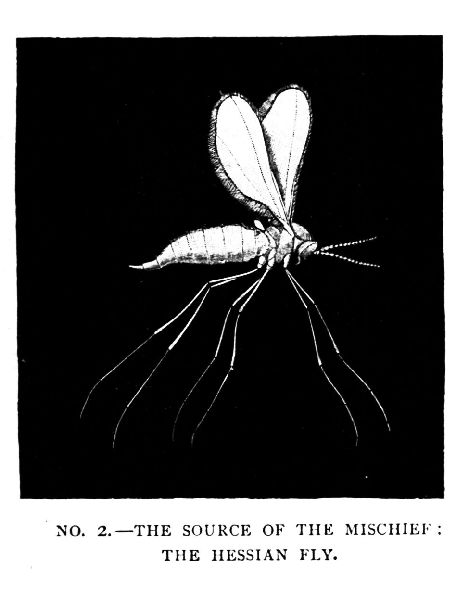
No. 2 shows the mother fly herself, very much enlarged, for in nature she is but a small black gnat, belonging to the same group as our old friend (and foe) the mosquito. You will observe that she is a fairy-like creature, for all her wickedness: she has two delicately fringed wings (with “poisers” behind them), a pair of long antennæ with beaded joints, six spindle legs, and a very full and swollen body. She needs that swollen body, for she is a mighty egg-layer. She flies about on the stubbles in September, and lays her eggs on the self-sown barley plants and on the aftergrowth of the cut crops; as well as in spring (a second brood) on the new sprouting barley. One industrious female which Mr. Enock watched when so employed laid no less than 158 eggs on six distinct plants; while another laid eighty on a single leaf. He has noted in detail many cases in the same way, and all show an astonishingly high level of maturity. The eggs are extremely minute, and are pale orange in colour, with reddish dots. Most of them are deposited on the leaf itself, or on the sheath or tube which forms its lower portion.
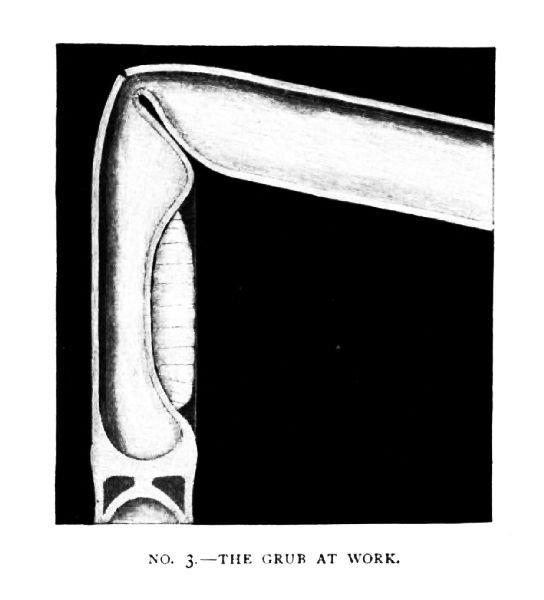
And now see how clever this dainty little creature is! She lays her eggs with the head end downward; and as soon as the tiny grub hatches, which it does about the fourth day, it emerges from the shell, and walks straight down towards the stem, at the point where the protecting leaf-sheath is wrapped closely round it. The worm forces itself in between the stem and the sheath, and after walking steadily for four hours, at the end of which time it has covered a record space of nearly three inches, it arrives at the joint, where the sheath begins, and so finds its way blocked by the partition wall; it can get no further. Here then the young grub stops, as you see in No. 3, wedged tightly in between the leaf-sheath and the stem, and with its head pointing downward. Being a hungry, and therefore an industrious creature, it at once sets to work to eat the barley-plant. This it does by fixing its sucker-like mouth on the soft, sweet, and juicy portion of the stem just above the joint — that same soft, sweet, and juicy portion which children love to pull out and suck, and from which the grub, too, sucks the life-juice of the barley-plant. Naturally, however, you can’t suck a plant’s life-blood without injuring its growth; so, after a very short time, the enfeebled stem begins to bend, as you see in No. 3, a little distance above the point where the grub is devouring it. It has been undermined, and its vitality sapped, so it gives way at once near the source of the injury.
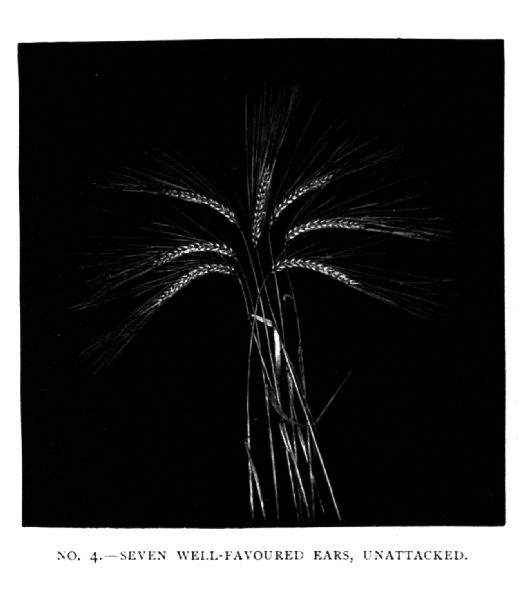
How much damage this action does to the crop you can best understand by a glance at the two next contrasted illustrations. No. 4 represents “seven well-favoured ears” of barley, unaffected by Hessian fly, and with the grains richly filled out as the farmer desires them; No. 5, on the contrary, shows you “seven lean ears,” attacked by the fly, and bent and ruined in various degrees by the indirect action of the silently gnawing larva. Look on this picture and on that, and you will then appreciate the British farmer’s horror of his insignificant opponent. You will observe, by the way, that I speak throughout of barley, not of wheat. This is because in England, where these sketches are studied, the time of wheat-sowing is such that the wheat has so far escaped the pest; the female flies are all dead before the crop is sprouted: whereas in America the “fall wheat” comes up at the exact moment when the female Hessian fly is abroad and scouring the fields in search of plants on which to lay the eggs of her future generations. In England, therefore, it is barley alone which is largely attacked; and since barley is mainly used for malting, to make beer or whisky, the teetotaler may perhaps reflect with complacency that the fly is merely playing the game of the United Kingdom Temperance Alliance. His joy, however, is fallacious, for, on the other hand, if we don’t raise enough barley at home to brew our ale, we don’t on that account refrain from malt liquors: we buy it from elsewhere; so that, in the eyes of the impartial political economist at least, the Hessian fly in Britain must be regarded as an unmitigated national misfortune.
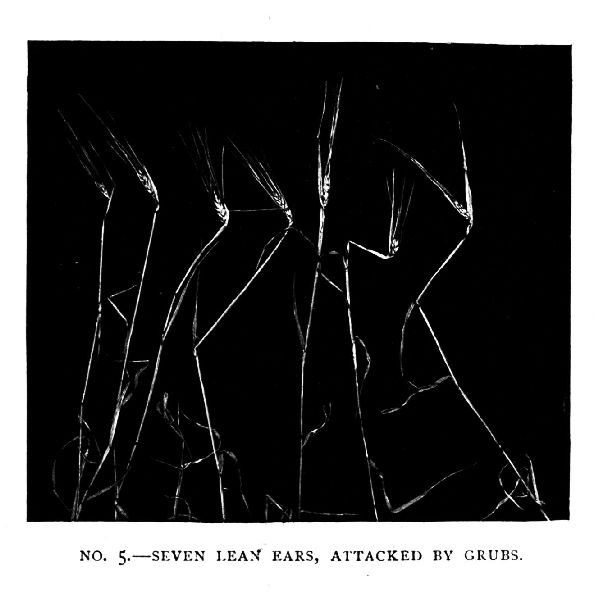
The grub eats and eats, in his safe cradle between the sheath and the stem, till he is ready to pass into the adult condition. But he does this by various and complicated stages, all of which I do not propose to set forth in full with the tedious minuteness of a scientific treatise, lest I weary that fastidious and somewhat lazy person, the “general reader.” It must suffice here to say, in brief, that the larva is at first soft and free, but that before becoming a true pupa or chrysalis he passes through an intermediate encased or “flax-seed” stage, in which he performs some curious evolutions. The young larva when he starts in life is whitish or yellowish; in the “flax-seed” stage he becomes a rich chestnut brown, and seems externally quiescent. But the fact is, he arrives at full growth in the white form, and then leaves off feeding; his skin now hardens and darkens, and he looks from outside very much like a pupa. Indeed, his outer covering is now a sort of solid pupa-case, in shape just the same as the original grub, but more sombre in colour. No. 6 shows you the portrait of the grub in this curious intermediate condition. If you compare it with No. 3, you will see that the outer skin still preserves the original shape of the fat young larva; but that the enclosed grub himself, here shown as if the case were transparent, has shrunk away from his own old skin, just as a ripe nut shrinks away from its shell, to borrow Mr. Enock’s admirable phrase for describing the process. And this strange shrinkage is connected with a very curious fact in the eventful life-history of the Hessian fly; it tells us of a problem which the grub has to face, and for which it has devised a most unexpected solution.
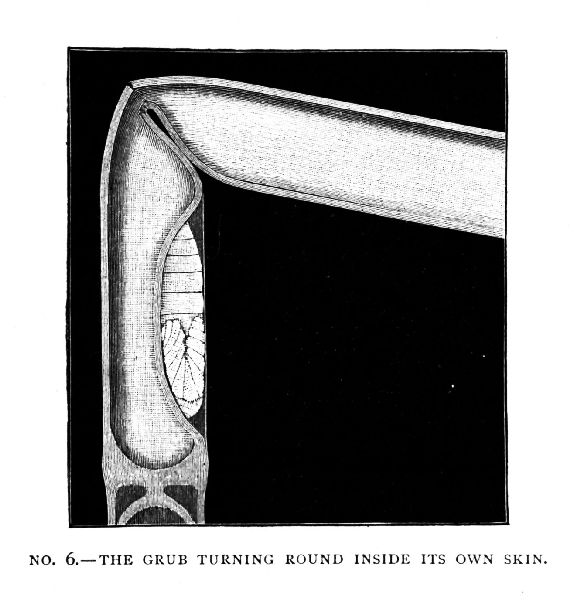
You remember that the young maggot had necessarily to work its way head downward along the stalk, in order to fix itself in the only place where it can find the soft food needful for it, between the sheath and the stem, where the tissue is tenderest. But when it emerges later on in the open air as a fly, it has to walk back again to the outer world above the joint; and this it could not do if it had still to go head downward. Yet there seems no room for it to turn in. Somehow or other, in that restricted space, it must reverse its position; it must get itself head upward. How is it to do so? This difficulty early struck Mr. Enock in his examination of the creature’s life; and with characteristic patience he determined to investigate it. His researches not only answered the question itself, but also discovered a meaning and purpose in a certain organ of the adult grub, the nature of which had heretofore been a standing puzzle to that section of society which interests itself prominently in the Hessian fly question. The larva in its “flax-seed” stage develops an odd and very hard organ, known as “the anchor-process,” near the head; and this “anchor-process,” as Mr. Enock has shown, is used by the grub to turn it round completely within its hardened pupa-case. (The last phrase, I will admit, is not quite scientifically correct, but I do not wish to complicate the subject by introducing a multiplicity of technical terms unknown to my readers.) In No. 6 you can see the adult grub in the very act of thus turning round, head to tail, within his outer skin, so that he may be able to emerge as a full-grown fly, head upward. A tiger is nothing to it, though a tiger moves within his own integuments more freely than most of us. You will note that during the feeding stage the grub’s mouth and under side were pressed against the stem; when he has performed this curious somersault on his own axis, so to speak, the head is uppermost, but the mouth and under side of the body are turned outward towards the sheath, not inward towards the stem and hollow centre of the barley-plant. He wants now to bite his way out, not to suck at the stalk for its nutritive juices.
I need hardly add that it takes some watching to detect such invisible movements inside a hard dark case; and only by the closest and most unwearying attention was Mr. Enock enabled to discover the true use and meaning of the so-called “anchor-process.” It is really not an anchor, but a sort of hooked foot or lever, by whose aid the apparently dormant grub turns himself bodily over within his own hardened skin, now become too large for his shrunken body.
Discoveries like these are hard to make; yet they bring little return in money or glory. But it is only by such patient and careful investigation that a way can be discovered to get rid of pests which cost civilisation many hundreds of thousands, nay, many millions, annually.
The grub in the turning stage is thus by no means what he looks — a dormant creature; on the contrary, he is a gymnast of no small skill and activity. The muscular contortions by which he seeks to free himself of discomfort when disturbed by man show that he possesses great power of contraction, and that he can exercise a considerable force of leverage.
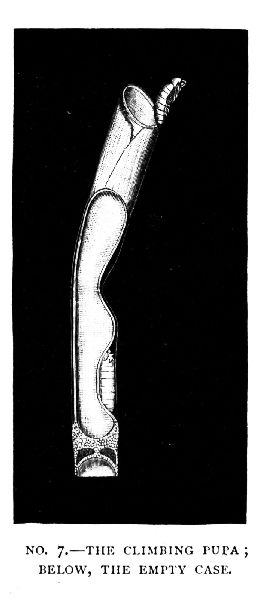
After the grub has succeeded in putting itself in position for assuming the winged stage, and emerging from its home head upward, it begins next to grow into a true pupa, or chrysalis. It is in the pupa, of course, that all winged insects acquire their wings and become definitely male or female, and this stage is, therefore, one of the most important. As soon as the grub begins to reach it, he swells once more and grows quite tight inside his larval skin, which is stretched so much that it seems to be bursting. At last, as he wriggles and twists within it, the skin does burst, first over the mouth and head, and then over the central joints of the body. Again the insect twists and wriggles inside this half-broken skin, and again he pushes it backward toward his tail, till at last he has sloughed it all off entirely, and it remains a shrivelled relic — an empty case — in the spot where he has hitherto lived and breathed and had his being. He is now a true pupa, white at first, but gradually growing a delicate pink, and then rosy.
Just at first, however, the pupa looks almost as formless as the grub it replaces, revealing no limbs or distinct segments. But little by little, feet and legs and eyes and wings begin to be visible through the semi-transparent shell of the chrysalis. He is changing slowly into a winged insect, and you can watch the change through the delicate horny coverings.
Stranger still, the Hessian fly at this stage is not torpid and quiescent like most ordinary insects. The pupa, as in many of this family, is locomotive. It has legs and feet, and it can wriggle its way up, as you see in No. 7, where the lower object is the empty larval skin, now deserted by its inmate, while the upper one is the pupa, emerging from the sheath, and making its first experiences of the wide, wide world outside its native leaf-bound hollow. It is ready now to come forth from the pupa stage, and to fly forth in the open air in search of a mate with whom to carry on the serious business of replenishing the fields with new generations of similar larvæ.
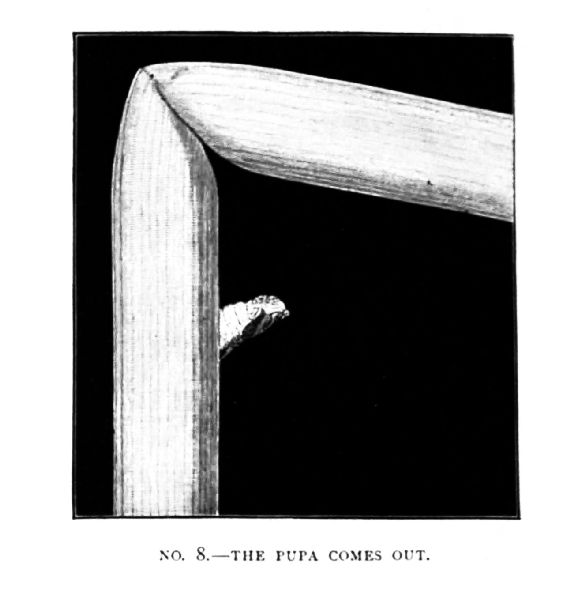
The succeeding illustrations show you in detail the various stages in the process of emergence. No. 8 gives you the beginning of emancipation. The pupa has here bitten its way through the leaf-sheath with its hard, horny jaws, and is protruding visibly. Just at first, only the head itself gets free; then the insect rests a while after its arduous labour, and begins wriggling and writhing again, this time working out its body or thorax. After another short interval for recuperation after such a terrific effort, it manages to pull its legs through the hole, and to support itself upon them by resting them like a bracket against the stem of the barley. This is the point just reached in the illustration No. 8. There the pupa stops short, having got himself into a convenient position for dispensing with his coverlet; for the sheath of the barley grasps the pupa-skin tight as in a vice, and he can wriggle his winged body free within it, without paying any further attention to the disused mummy-case which once confined it.
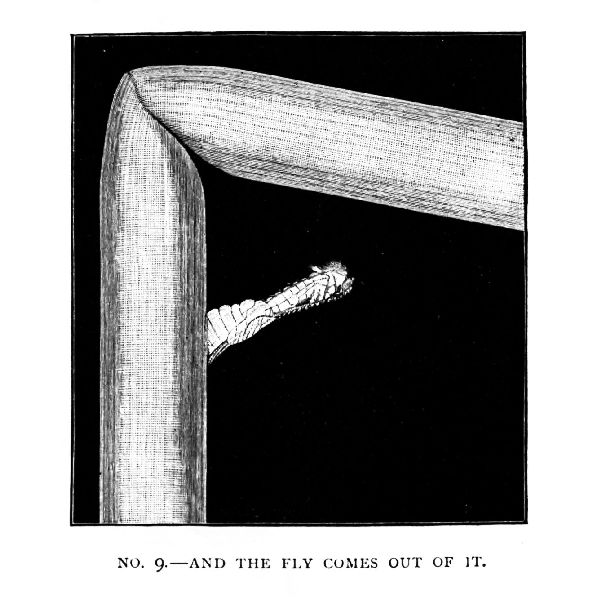
In No. 9, the pupa being thus safely anchored, the fly is emerging. It is a slow and delicate process, for with so many legs and wings and antennæ and appendages to get free from the mummy-case, one cannot hurry: haste might be fatal. At this first stage of emergence, as you will observe, all the important parts are still cramped at their ends within the pupa-shell; but you can see how the legs and antennæ are striving to disengage themselves. The pupa covering is propped as before by the empty leg-shells so as to form a bracket.
In No. 10 — hurrah! with a supreme effort, our fly has got her antennæ free! She can move them to and fro now, in all their jointed and tufted glory. That enables her to wag her head in either direction without difficulty, and encourages her to go on to fresh exertions for the rest of the deliverance. But her feet are still fast in that hampering mummy-case; she must try her hardest now to free them each carefully.
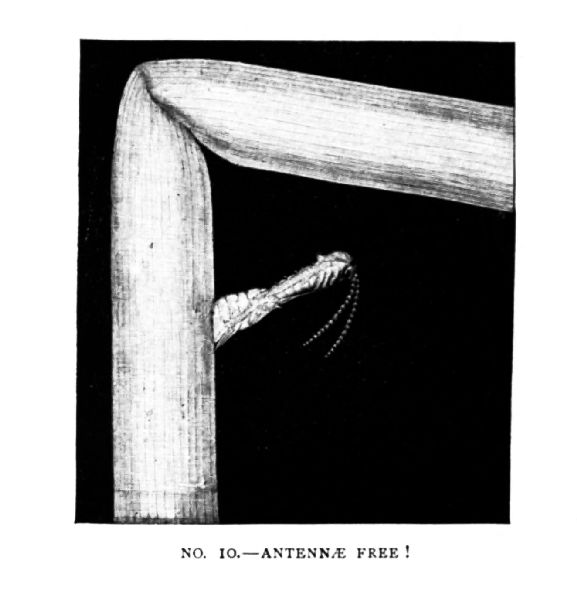
First, however, let her get the tips of her wings free to help them. One good jerk and out comes the first wing. Now she bends backward and forward and seems straining every nerve. Halloa, that did it; the other wing is free! Not as yet, however, plimmed out and flattened as it will be a little later; both wings at present look somewhat thick and lumpy and stick-like. Such as they are you see them in No. 11, rather clumsy specimens, while our lady goes on with redoubled energy, now concentrating her efforts on her front pair of legs — for when you have six to think of, one pair at a time is about as much as you can easily manage.
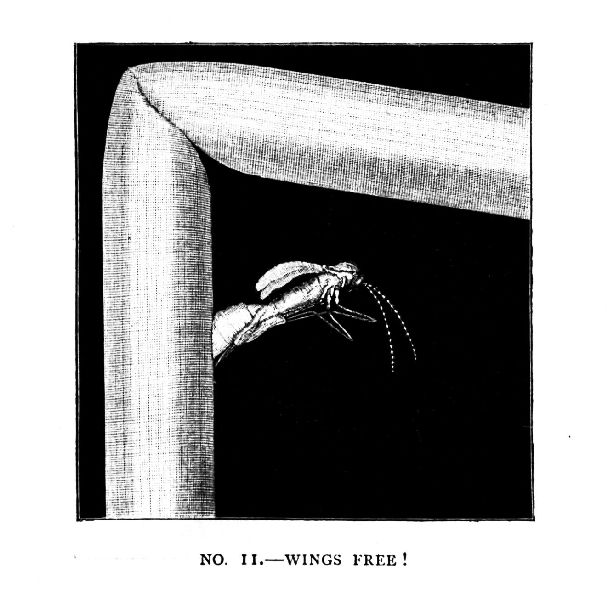
In No. 11, the first pair, you will note, is all but free. She wriggles out one of them, and then its fellow. Oh, how she tugs and pulls at them! Meanwhile, the tufts of hair on the antennæ, which at first were bunchy and little developed, have begun to expand; she looks, by this time, distinctly more like a respectable insect. Well done, once more; two pairs of legs now free. No. 12 shows them. But, take care; we are getting now rather far out of the mummy-case. Be sure you don’t overbalance, and tumble bodily out, tearing your hind pair of legs off, with the force of your fall. Those thin shanks are brittle, and you find little support now from the empty skin and the hollow bracket.
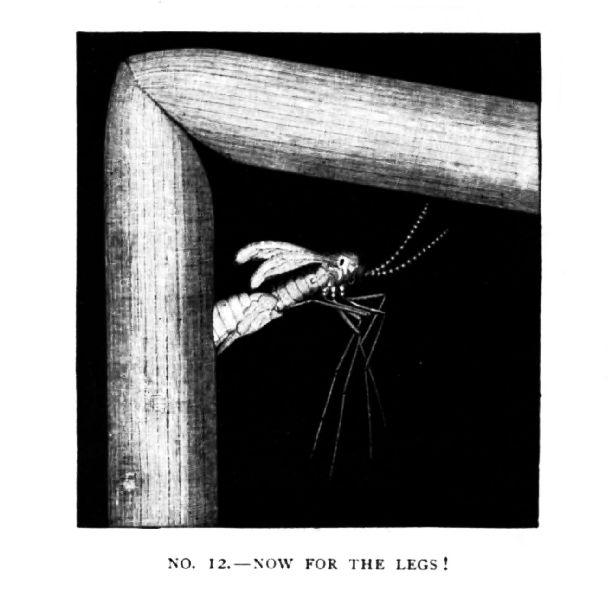
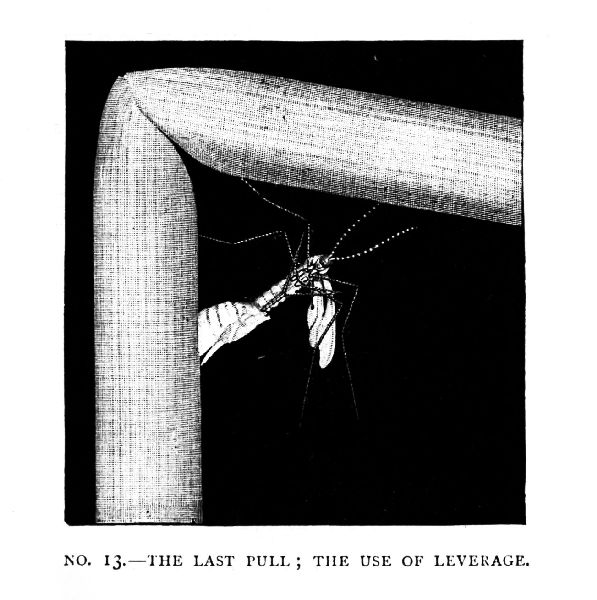
Nature, however, is wiser than her critics. Just when it looks as if next moment the fly must lose her balance and topple over, she twists suddenly round, with a dexterous lunge, catches the bent stem with two of her free legs, and anchors herself securely. No. 13 shows how this is done. Below is the now almost empty pupa-shell, still enclosing the last two legs, on freeing which our astute little enemy is busily occupied. But with the two legs on her upper side (as she stands in the illustration) she has caught at the barley-stem, one foot being firmly planted below the bend, and one above it. This gives her a fine purchase to depend upon in her last wild blow for freedom. A long pull, and a strong pull, and she has got — what the modern woman so ardently craves — complete emancipation! The third pair of legs are out at last; she has all the world before her to wander over and lay eggs in.
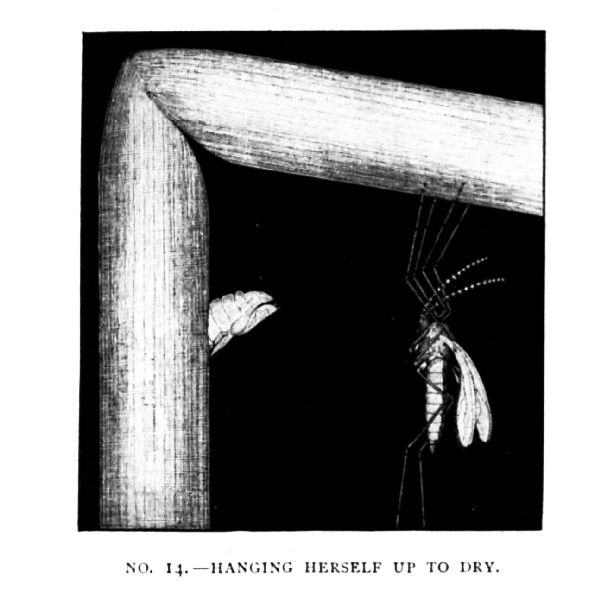
In No. 14 you see her, then, free, but resting. She has now shaken herself out, and left her empty mummy-case imprisoned at her side in the sheath which holds it. Its fate no longer interests her. Then she crawls a little way along the surface of the barley-stem, and presently, clasping it with her four front legs, she hangs herself up, tail downward, to dry in the sunshine. No. 14 graphically represents this curious position. Almost all flying insects, when they emerge from the chrysalis stage, do something analogous. Their wings are still club-like, their antennæ undeveloped or not fully expanded, their jointed legs weak and groggy. But after a time, as they breathe or inflate themselves with air, all these parts grow fuller, lighter, and harder. The Hessian fly in this predicament waves her wings to and fro several times across her back; and in about a quarter of an hour they have plimmed out fully, so that she can soar away on her marriage flight to meet her prospective aërial husband. As for the tiny silvery shroud or deserted pupa-case, it is left protruding from the stem of the barley.
This that I have given you is the history of a successful and fortunate fly; but not every individual of the species is quite so lucky. As in the case of the mosquito, nature at times makes not a few failures. Sometimes the flies have insuperable difficulty in freeing themselves from their articulated coverings; sometimes they break or spoil their legs or wings, and become helpless cripples. Yet so strong is the impulse of every species to fill the world with its like that sometimes, says Mr. Enock, even these poor maimed insects will manage to crawl to a proper food-plant, and will lay their eggs on it bravely like their more fortunate sisters. He noted one crippled female which in spite of its feebleness was eighty times over a happy mother. This is usually the case with such small insect pests; their life consists, indeed, of two things only, eating their way to the winged stage, and then laying as many eggs as possible, to do like damage in the next generation.
Three or four hours after emerging, when they have had time to accustom themselves to the outer air, the male flies soar abroad on gauzy wings to seek their mates; the ladies, on the contrary, are coy, not to say somewhat sluggish, and oftenest wait at home on the under side of a leaf till their lords come to woo them. The well-bred Hessian fly does not gad about to seek a husband. But that is only while she is a maiden; as soon as it comes to laying eggs, she wakes up at once, and takes to business with the utmost energy. She flies off around the fields and looks out a fresh young barley-plant, suitable for a nursery. On its leaves she alights, with her head towards the tip of the blade, and begins depositing her precious burden. When once she has started, she sticks to it for life, using herself up (like our old friend the aphis) in the duties of maternity, and laying as many eggs as she possesses material for. Her conduct, in short, would be exemplary, if she wasted her life on thistles or nettles, and didn’t choose to display her maternal affection on the British farmer’s barley. So she goes on till she has worn herself out, and often till she has broken three or four of her legs in the pursuit of duty. Then, when she grows quite exhausted, and feels her latter end drawing nigh, she hides herself in the ground — buries herself alive, in fact; and there awaits death with patient resignation.
The average lifetime of the Hessian fly in the adult winged stage seems to be about five days for the females, and probably a good deal less for the males. The bachelors in search of a wife fly sometimes for long distances across country; but their prospective partners are almost always shyer and more maidenly; they hide under the leaves and travel but short distances, considering it more ladylike to stop at home and wait for suitors than to go out and seek them. They are not new women. Indeed, so great is their modesty that they often hide in holes in the ground to escape observation; and they usually alight on the earth, as their colour is blackish, and they are there less exposed to the attacks of birds and other enemies than on the green foliage. It is a noticeable fact in nature that many species of animals seem thus to know instinctively the colours with which their own hues will best harmonise, and to poise by preference on such colours; many dappled or speckled insects, for example, resting with folded wings on the dappled and speckled flower-bunches of the carrot tribe, while green insects affect rather green leaves, and brown or black insects come to anchor on the soil, which best protects them. This is not quite the same thing as what is called protective colouring, such as occurs in desert animals, most of which are spotted like the sand, or in the fishes and crabs which frequent the sargasso-weed in the Sargasso Sea, all of which are of the same pale lemon-yellow tint as the seaweed they lurk among; for this case of the Hessian fly includes a deliberate choice of ingrained habit. The insect has many objects of many different colours spread about in its neighbourhood, but it habitually selects as its resting-place those particular objects which most closely approach its own peculiar ground-tint.
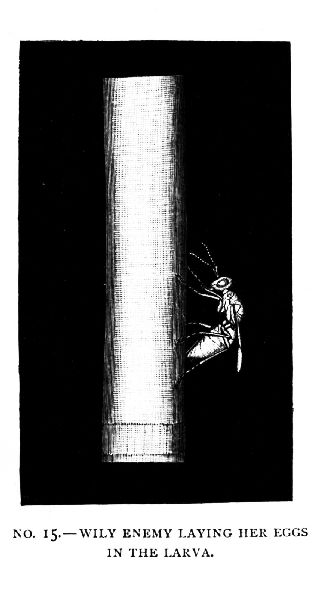
It is a curious fact, however, that in spite of all the apparent pains bestowed upon securing the perpetuation of such destructive creatures as the Hessian fly, the pest itself has its own enemies, as fatal to its life as it is to the barley. Ichneumon flies and other parasites prey by millions on the Hessian fly in its grub condition; and many good authorities believe that the safest way of checking the depredations of the barley-plague is by encouraging the multiplication of its natural enemies. No. 15 shows us one of these industrious little scourges actually at work. She alights on a stem of barley infested by grubs of the Hessian fly, and walks slowly along it, tapping gently as she goes, much as a woodpecker taps with his bill on a tree-trunk to discover the spot where a worm lies buried. After carefully examining the surface, she finds at last a place where something, either in the sound or the feeling of the stem, reveals to her the presence of a Hessian fly grub within the leaf-sheath. Having accurately diagnosed the spot (like a doctor with a stethoscope), she brings her ovipositor (in plain English, her egg-layer) just above the place where the grub is lying snug in its green bed, and pierces the hard leaf-blade with her sharp little lancet. Then she lays her egg in the body of the larva. This egg gives rise in time to a parasitic grub, inside the first one; and the parasite eats out his host’s body, and emerges in due time as a full-grown fly, ready to carry on the same cycle in future. More than nine-tenths of the Hessian fly grubs hatched out in America are thus destroyed by parasites before they reach maturity; and it seems likely that the surest way of fighting insect plagues like the Hessian fly is by encouraging the increase of such natural destroyers.
At first sight, to be sure, it may seem improbable that man could do anything to “encourage” the reproduction of such very small creatures; but that is not really so. All that is necessary is to keep the straw in which the parasitic grubs abound, and so allow the two hostile kinds to fight it out among themselves for the farmer’s benefit. Mr. Enock mentions an instructive case of this sort from America, where the Californian orange-growers were almost being ruined by the depredations of the scale-insect, a queer little beast which you may often find on the rind of certain imported oranges. But an enemy to the scale-insect was discovered in Australia — an enemy to the scale-insect, and therefore an ally of the harassed orange-grower. It was a particular kind of lady-bird, which devours in its larval stage whole tribes of the scale-insects. That wonderful entomologist, Professor Riley, whose services were worth many millions of pounds to the American farmers, got wind betimes of this new destroyer, and imported a few specimens, actually sending a skilled agent to Australia to collect them. The precious little creatures were housed at once in a muslin tent, covering a scale-infested orange tree; and there, rising to a sense of the duty imposed upon them, they laid their eggs on the leaves with commendable promptitude. The larvæ soon hatched out, and began feeding upon the scale-insects; and in an incredibly short time there were beetles enough on that single tree to distribute by boxfuls among the distressed agriculturists. The result was that before very long the scale-insect became a rare specimen in California. But that was in the United States; English folk are too “practical” to take any notice of those theoretical men of science. They put their hands in their pockets and let their crops get destroyed in the good old “practical” way; then they shake their heads and observe with a smile that “there are great difficulties” in the way of doing anything.
THE END